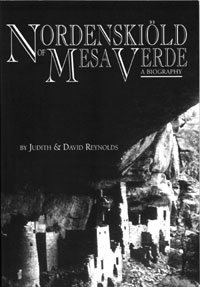|
|
||
|
Wandering into Mesa Verde by Amy Maestas Nordenskiöld of Mesa Verde: A Biography, by Judith and David Reynolds; 190 pages; Xlibris Gustaf Nordenskiöld may figure prominently in the history of Mesa Verde National Park, but to limit the infamous Swede to only this association would be shortchanging the young man's contributions to the larger world of science - and the future of all American archaeology. Evidence of that is found in a new - and the first complete - biography of Nordenskiöld, written by Durango authors Judith and David Reynolds. Nordenskiöld of Mesa Verde is indeed a thorough investigation of the man who was among the early explorers of the national park outside Cortez. Still a relatively isolated mesa and a full 15 years from receiving its official government park designation, Nordenskiöld's brief but intense months spent there in 1891 ended up guaranteeing the makings of a good story - high stakes, unknown outcome and important characters. Over the years, many stories did swirl among various circles, some good and some bad. But many of them failed to provide a more inclusive view of Nordenskiöld until the Reynolds's book. Instead of focusing on Nordenskiöld's explorations and subsequent removal of antiquities of the ancestral Puebloans, the authors take readers on their own expedition from the explorer's childhood in Sweden to his worldwide wanderings post-college, which eventually led him to Southwest Colorado. The span of the story is important, because Nordenskiöld's privileged upbringing as the son of a professor and indefatigable head of the Swedish expedition of the Northeast Passage by sea (his father) and an exceptionally patient and supportive woman (his mother) set him up for success in his various adventures. The young Nordenskiöld received his education from elite Stockholm schools that seemed tailor-made for his enthusiasm for collecting, documenting and reporting on his endless discoveries. His overachieving father encouraged the passion, even as he pursued his own. The family was financially able to back the child's increasing adventures during his summer breaks and post-college years. With that freedom, Nordenskiöld was on the loose - paving his own way in the scientific world.
The young Nordenskiöld received his education from elite Stockholm schools that seemed tailor-made for his enthusiasm for collecting, documenting and reporting on his endless discoveries. His overachieving father encouraged the passion, even as he pursued his own. The family was financially able to back the child's increasing adventures during his summer breaks and post-college years. With that freedom, Nordenskiöld was on the loose - paving his own way in the scientific world. Culling facts and anecdotes from a spectrum of historic artifacts (letters, drawings, news items and photographs), the authors piece together their main character and his peripatetic lifestyle. It is a phenomenally well-researched book with just enough details to not drown readers in a reportorial history lesson that has been retold for decades. Each story's significance factors into the time that Nordenskiöld spent at Mesa Verde. That is the book's strongest point. It was Nordenskiöld himself who created the drama that makes the story so good. And dramatic it is. His years in Scandinavia were chock full of tales befitting a highly educated and spoiled (though seemingly humble) kid. While staying in Durango, Nordenskiöld narrowly escapes detention and hefty federal charges that would no doubt bring disrepute to his family's name and social ranking. But it is Judith and David Reynolds who deserve ample credit for recasting the plot and bringing the drama into a new light. Single-handedly, the authors are able to change most peoples' vision of Nordenskiöld as a thieving, ignorant foreigner whose opportunism forever changed the landscape of a sacred land. He was, after all, excitedly digging up artifacts and shipping them to his motherland, where they would remain - then and now - strangely out of place. That vision can only go so far after reading the authors' book. This "new" Nordenskiöld, so to speak, is a complex man whose short life (he died of tuberculosis at age 26, leaving behind a wife and small child) accomplished more than even the most experienced scientific explorers. His contributions as a progressive thinker and diligence in raising the bar for researchers reach farther in history than his somewhat naïve and mostly well-intentioned foray into Native American archaeology. His complete story is finally given its due in this book that is impressive in breadth and scope. Though relatively short, most likely because of Nordenskiöld's early death, the authors write this book with skill, giving full-dress treatment to who this young explorer was and what made him that way. Anyone with even an inkling of interest in Southwest history will be well served reading his story.
|
In this week's issue...
- May 15, 2025
- End of the trail
Despite tariff pause, Colorado bike company can’t hang on through supply chain chaos
- May 8, 2025
- Shared pain
Dismal trend highlights need to cut usage in Upper Basin, too
- April 24, 2025
- A tale of two bills
Nuclear gets all the hype, but optimizing infrastructure will have bigger impact


